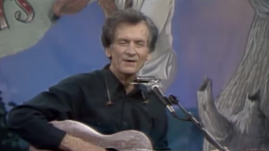Teachers' Domain - Digital Media for the Classroom and Professional Development
User: Preview



Folksinger Mike Seeger performs the English-American song “Derby Ram” for a group of students who sing, stomp, and clap along. Seeger explains, “Exaggeration is the core of this English-American song reputed to be one of George Washington’s favorites. I’ve been singing this version since I was about 12.” The guitar and harmonica are featured instruments.
Find additional arts resources for your classroom at the KET Arts Toolkit website.
“Derby Ram” is an England/American Colonial folk song that describes a humongous ram in the town of Derby. The song is obviously an exaggeration of a ram seen in Derby, England, on a market day. The origin of this ballad is uncertain, but it is more than 200 years old. It was set to music by either Dr. John Wall Callcott, a Londoner (1776-1821), or his son William Hutchings Callcott (1807-1882). Llewellyn Jewitt wrote about the song in his book The Ballads and Songs of Derbyshire of 1867.
The Derby Ram was the mascot of Derby County, England. In 1855, the Derby Militia took a ram as their mascot, and it would march their drills with them. The Derby Ram is known to people throughout the world and continues to be prominent in the town of Derby. Walking through the town of Derby today, one can find statues, shirts, and various memorabilia devoted to the beloved Derby Ram.
Many versions of “Derby Ram” have been sung over the decades. Like many other English folk tunes, “Derby Ram” made its way to America. In America, it evolved over time into a ragtime classic and even a jazz classic entitled “Oh, Didn’t He Ramble.” This old English ballad is said to have been a favorite song of George Washington. Stories have been recorded of General Washington taking children on his knee and singing this song.
In this performance of “Derby Ram,” Mike Seeger, an acclaimed traditional singer, uses interesting dynamic and tempo contrasts. His voice and guitar start at a medium dynamic, and then the harmonica comes in at a louder dynamic. His guitar and singing get louder after the harmonica. He speeds up the tempo at the end of the song as well, which adds to the fun.
 Loading Standards
Loading Standards